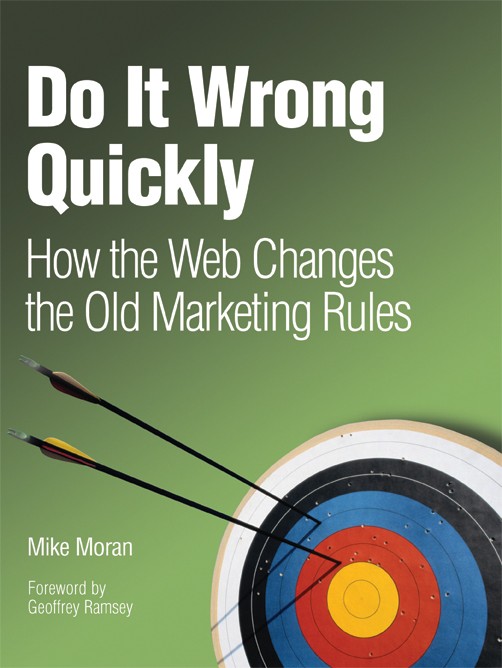
Do It Wrong Quickly: How the Web Changes the Old Marketing Rules
The Agile Approach to Digital Marketing
by Mike Moran
Do It Wrong Quickly might strike you as strange advice, but experimentation is at the heart of successful digital marketing. Before agile marketing was dubbed “agile,” there was Do It Wrong Quickly. Named one of the 11 best business books of 2007 by the Miami Herald, one of 25 Essential Reads for Web Pros by Website Magazine, and one of Top 100 Social Media Books Ever by Mellow Billow, Do It Wrong Quickly is a groundbreaking call-to-action.
Description
Instead of killing yourself as you spend months obsessing over everything that could go wrong with your new campaign, it’s cheaper, faster, and more effective to just try something.
Marketers have become careful over the years because getting a TV commercial wrong is career death. Because it costs so much money, requires so much lead time, and is so hard to change, TV advertising is the pinnacle of the “do it right at all costs” approach.
But digital is different.You can buy paid search ads today and change them tomorrow if they’re not working. Experimentation and fast changes are the only way to find out what’s right:
- Listen to what your customers say. The web gives your customer a printing press to express opinions that you’d never have heard back in the good old days. Customers are already talking about you on social media. Are you listening?
- Watch what your customers do. The internet is the biggest direct marketing play of all time. You can measure the response of your customers to everything you do. By carefully designing your experience, you can gather feedback based on every click. Your customers are voting with their mice. Are you watching?
- Respond—quickly. Accept the fact that none of us can predict what our customers really want. We’re not setting out to do things wrong, but we can accept that we are doing it wrong most of the time. The point is that we need to find out that it’s wrong and fix it—fast. It’s amazing how smart you’ll look when you respond to what your customers say and do. Are you responding?
These changes are not easy in many companies. Careers are ended with big mistakes, so admitting you don’t know what customers want and you’d like to experiment to find out—that might seem like a career-killing move. Do It Wrong Quickly is full of practical advice and stories from leading marketers on how to change the way your company does its marketing.
reviews
Marketing Pilgrim
Complete Review
Maneuver Marketing Communique
President of Internet Search Marketing
Complete Review
Complete Review
The Journal of Product Innovation Management
Complete Review
praise
What’s the one thing companies care about? Conversion. Getting potential customers to convert into real, actual, customers. But how do you do that in a world of Facebook, Google, YouTube, blogs, and Flickr? Mike Moran shows you how—by trying lots of little things, studying the results, learning quickly from your failures, and doing all over again. He gives you a framework for getting over your fears of talking with your customers without a committee to protect your behind. Great book.
Video blogger of the Scoble Show and
co-author of the top-selling corporate blogging book, Naked Conversations
Author of the #1 Wall Street Journal bestseller Waiting for Your Cat to Bark?
Director of Digital Media Marketing for the National Football League
Executive Vice President and Chief Information Officer for Charles Schwab
Chief Marketing Officer for E-LOAN
Founder of the Internet Strategy Forum
Executive Editor of SearchEngineLand.com, and Author of Google Power and
The Invisible Web
CEO of TopRank Online Marketing and publisher of MarketingBlog.com
President and CEO of Enquiro
Vice President, World Wide Marketing, Coremetrics
CEO, Converseon, Inc.
Marketing Director of JupiterResearch Nordic
Author of WebMetricsGuru blog
